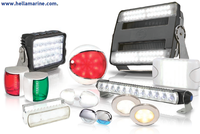Posted by Hella Marine on 16th Mar 2016
10 Things to Consider when purchasing LED Lighting
Everyone knows the benefits of LED lighting compared to traditional incandescent bulb based lighting. It is well published that LEDs Luminaires are some 90% more efficient and also have an up to 25 times longer life span. So the decision to change from incandescent to LED technology is an easy one. However, comparing LED based lighting to halogen lamps is like comparing apples and oranges.

With so many LED products on the market how do you decide which ones to purchase?
If you are looking at upgrading or building new with LED lighting there is usually a substantial cost involved so you want to make sure you select the best lamps for your purpose and that they will provide the return on investment. This means they should last as long as promised and provide the light performance desired. It is important to compare apples with apples as they say.
Here are the 10 most important things to consider when deciding to invest in LED lighting.

Not all LED lights are created equal!
1: Light Output
There are large differences of LED Luminaires in light performance for the power consumed (lumens per watt). Unlike traditional incandescent lamps or halogen lamps where the amount of power a lamp uses (wattage) is usually a pretty good indication for how bright it will be.
The same applies to color reproduction. For halogen lamps this is quite consistent. One LED lamp can be very different from another.
Lumens are a common measurement used to describe the amount of light a lamp produces.
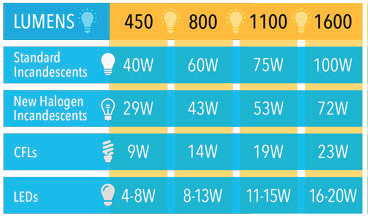
Example of suggested lumen comparisons
This measurement is too often based on the LED’s manufactured rating (Raw Lumens). This however is can be misleading and not the actual measure of useful light emitted by a LED lamp.
Factors such as the power used to drive the lamp, thermal losses and optic and lens losses as light rays travel through the lens all contribute to a possible 20-50% decrease of the light lumens emitted by the LED. Good optic skills, circuit design and material selection are required to minimize internal lumen losses.
The best measure of a lamps true light output is by comparing lux diagrams.
Lumen ratings can be misleading because they refer to the total light emitted from a Luminaire, no matter whether this emitted in a useful direction. Lux and candela ratings refer to the actual light intensity from the lamp at given distances and direction. This way you know what light levels to expect when designing your lighting layout.
Quality lighting manufacturers, using state of the art photometric equipment, are able to provide accurate lux or candela charts so consumers get a fair representation of the expected Luminaire performance.


Lux and Candela charts are more useful measurements when comparing LED lamp output
For accurate light performance,compare Lux Charts.
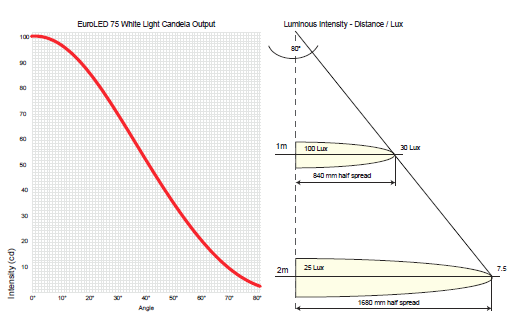
Hella marine use lux and candela diagrams to illustrate accurate light output and beam angles
Other aspects to consider when reviewing luminaire performance include beam angle, and evenness of illumination, as well as color temperature and color rendering which we cover in later sections.
2: Beam Angle
If you stare directly into a LED luminaire, chances are it will appear bright and dazzle you. In fact, looking directly at some of the high power LED chips for extended periods can be hazardous to the eye.

The better optic design shows an evenly bright surface of the entire luminaire without any bright spots. Hella marine LED lamps use efficient lens and optic designs to reduce glare and eye strain while still projecting the light in an evenly distributed pattern. For example, down lights will often have a wide spread optic to fill a room and by overlapping the wide spread beams from several Luminaires shadows are much reduced, where as other lamps like spotlights or courtesy lighting may be designed to focus or direct the light in a specific direction to achieve a specific effect.
Make sure you select a light with a lens and optic design that reduces eye strain and a light pattern to suit your application.
3: Power Consumption
As mentioned earlier, LED lamps can save up to 90% of power compared to a traditional incandescent lamp.
It is a common misconception that all 4W lamps produce the same light performance. A well designed 3 watt LED lamp can produce a lot more light than a 4-watt lamp. Much of the performance greatly depends on the LED use and as mentioned earlier the quality of the optic, thermal management and electronic.
Do not judge an LED on Wattage alone, as two different 4 watt lamps may not have the same light output.
As LED technology is steadily advancing manufacturers have been able to produce LEDs with a much greater lumen per watt performance. This means lamps are getting brighter and your power consumption from lighting is reducing. So efficacy, which is the measurement of lumens per watt, is an important consideration.

Graph illustrates how mass produced LEDs have become more efficient over the last decade.
Note: measurements are raw (theoretical) lumens per watt.
Comparing lumens per watt.
If possible, try and compare the lumens per watt to get an accurate measurement of how the percentage of the power is being used to effectively generate light.

Based on manufacturers listed Lumen’s and power consumption Hella marine EuroLED 75
lamps have exceptional efficacy ratings (lumens per Watt)
Although LEDs run cooler than incandescent lamps they still generate heat and need to be cooled. The more power used in a LED lamp the more heat is generated and this can adversely affect the long term lamp performance.
Hella marine frequently upgrades its products to the latest LEDs technology from renowned manufacturers. Our drive circuits never drive the LEDs to their maximum rated current. This means Hella marine products are less likely to degrade in light performance and ensuring a longer economic life.
4: Color temperature (Kelvins) and Rendering
Index (CRI)
When white LED lighting first became available it quickly gained a reputation for creating cold or blue color tones. As technology has developed LED color temperatures have advanced and today LED Luminaires are available in a wide range of colors temperatures, from similar to natural day light or the warm tungsten glow of traditional incandescent lamps.
LED colors set the tone and feel of your vessel so choosing Luminaires that complement your interior or exterior is important.

Hella marine LED interior lamps are usually available in either 2700-3000K (warm white) or
5000K (day white) color options
Think about what feel you want on your vessel. Cooler white colors (5000K) usually suit white gel-coat boats and exteriors while lush upholstery or varnished timbers look and feel better with a warmer (3000K) light.
Look for interior lamps with an 80+ color rendering index
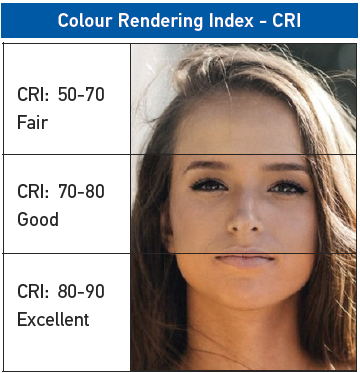
CRI ratings >80 produce natural colors
As LED technology continues to advance so does the color rendering ability of LED’s. The higher the CRI rating the better and truer color reproduction you will get of various objects. For example, sunlight has the highest CRI rating of 100. LED lamps with a CRI rating of 80 or higher will reproduce the color scheme of the interior with good accuracy.
It is also worth explaining that after LEDs have been manufactured they get selected into various grades based on their color temperature and efficiency.
Hella marine ensures they use the same brightness and color temperature grade is used to ensure consistency of the luminaire, meaning a number of lamps fitted to a room will all have the same appearance e.g. color temperature and intensity.
5: Thermal Management
The notion that LED lamps run cool only holds true compared to incandescent lamps that are too hot to safely touch after operating for a short period. Fact is the LEDs and the electronic do heat up and if not cooled effectively will affect the light performance and the expected life span of the lamp. A very hot running LED Luminaire can cause issues interacting with the surrounding materials, particularly in recessed lamps, that prevents the heat to dissipate.

High power LED lamps do generate heat so the lamp needs to be designed to efficiently transport this heat away from the LED itself. LEDs that overheat, meaning the junction temperature of the LED rises above a set threshold, will permanently degrade, significantly reducing their luminous efficacy.
Well engineered thermal management of a LED device is essential for long-term reliability.
High output lamps should be designed to dissipate heat through heat sinks or thermally conductive materials. Hella marine use aluminum housings with radiating cooling fins to dissipate heat over large surface areas away from the lamp.
Hella marine has also introduced a revolutionary new ceramic based thermal polymer that has unique heat distribution properties. This will be explained further when we discuss the importance of the materials used to manufacture durable and reliable LED lamps.
6: Materials
Maritime environments are very harsh, salty, high humidity coupled with strong UV. Lamps manufactured using low grade corrosive metals or poorly coated alloys soon degrade and rust. This can cause unsightly rust stains on the vessel and blemish the appearance of the lamp. Eventually the housing and sealing systems will break down allowing moisture to enter the lamp. Once this happens it’s only a matter of a short time until the electronics fail.
Durable housings are needed to protect internal components and electronics.

Most consumers will have purchased and experienced products made from plastic materials that deteriorate, fade and become brittle very quickly when exposed to the sun. Continuous exposure to UV can also cause LED lamps to become brittle and crack which eventually enables water or moisture inside.
Hella marine only manufactures products from materials which are highly resistant to UV radiation, salt and permanent high humidity.
Hella marine products are manufactured using high quality, corrosion resistant materials that have been tested and proven to be extremely durable in the marine environment.
For exterior and high impact areas Hella marine has introduced Grilamid® as the material of choice.

Offering excellent transparency (similar to glass) and characterized by its very high impact and fatigue strength Grilamid® is also resistant to long term UV exposure and chemically induced stress cracking.
Metal heat sinks are generally used to disperse excess heat away from the lamp and cool the LEDs, however metal based lamps that have not been well coated can quickly corrode or the coating can flake off in the harsh marine environment. This results in unsightly appearances and seals can get compromised allowing moisture to then access sensitive electronic circuits. Hella marine have introduced a new high grade Corosafe coating for aluminum products that are subjected to the harsh environment.

Hella marine have also started using a revolutionary new ceramic polymer with outstanding thermal performance.
New Ceramic Polymer housings provide complete corrosion resistance.
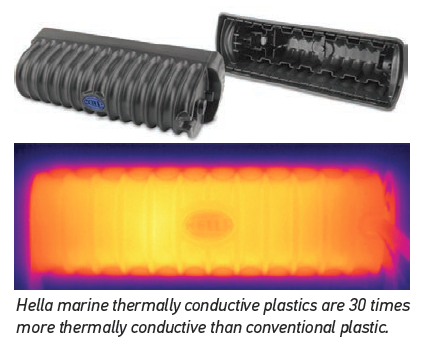
The replacement of metal based housing heat-sinks with thermally conductive plastic not only opens a myriad of design options, but also removes potential surface deterioration and corrosion risks.
This is especially important in demanding environmental conditions such as the corrosive, salt laden, moist marine environment where lights are constantly exposed to the elements and sometimes temporarily submerged.
The other benefits of using this new ceramic thermal polymer is this material can be precisely molded, meaning Hella marine can maintain exact dimensions for precision fitments.
Less metal also means less weight: Lamps with thermally conductive plastic are up to 60% lighter than comparable metal bodied lamps. The much lower mass significantly reduces the stress on mounting points in high vibration and shock applications.
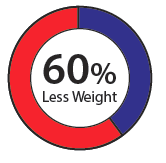
7: Sealing (IP Rating)
As LEDs are electronic devices it is important to protect them from moisture and other contaminants that will degrade or harm the lamp. In a marine environment this is even more important as the chance of getting water, condensation or salt spray around the lamp is highly likely even in interior applications.

Examples of different LED manufacturers and methods of sealing lamps.
Look for lamps with an IP 67 rating.
The most effective way to protect the lamp and its internal components is by completely sealing the lamp.
All commercial and leisure Hella marine LED lamps are at least IP 67, meaning the same luminaire can be
fitted to both the interior and exterior on your vessel, in either wet or dry conditions. With the same fully sealed
LED light fitted both on the interior and exterior, a consistent lighting scheme can be kept and the vessel can be safely cleaned or water blasted without fear of water ingress into the lamps.

8: Electro Magnetic Interference (EMI)
Electromagnetic Compatibility (EMC) is an increasingly relevant safety concern, especially for many emergency and industrial applications. As electronic devices such as LED lamps become more common, so does the risk of unintended electromagnetic interference (EMI) that can have adverse effects on other sensitive devices such as radios or communication equipment.
All Hella marine LED products are tested and certified to international standard CE for electromagnetic interference. Hella Marine recognizes the importance of low emissions, so products are designed to have values significantly below the recognized levels for international standards, and lower than market norms.
In addition, due to market requests Hella marine has also introduced a new RFCommSafe™ range of products, developed in recognition that some radio communication equipment can self-tune to be very sensitive in remote locations. In these situations, the limits prescribed by regulatory requirements and as defined in international standards such as EN 60945, IEC 61547, EN 55015 (CISPR 15) standards may not be sufficient to ensure there is no interference with very sensitive radio.

communication equipment. IEC 61547, EN 55015 (CISPR 15) standards may not be sufficient to ensure there is no interference with very sensitive radio communication equipment.

Hella marine’s new RFCommSafe™ range is proven to have no noise and will not interfere with other electronic devices.
9: Warranty
We hope this booklet has been helpful to explain the many factors that contribute to the design and manufacture of quality and reliable LED lamps. Depending on the brand of LED lamp purchased you can expect between a 12 month and 7-year warranty and this commitment of the manufacturer will be an indication for the confidence level a manufacturer places in the long-term durability of his product.
Buy from a trusted brand which has a reputation to stand behind their products. 
All Hella marine LED lamps have a 5-year warranty with the exception of the NaviLED Tri-color Anchor lamp which carries a 7-year warranty. Our long warranty term serves your peace of mind that the product you purchase from us will not only work flawlessly for a long-time but will also maintain its appearance. Should you have any issues or need to claim under our warranty, Hella marine has an extensive distribution network in over 30 countries.

10: Cost
Obviously cost is an important consideration when making a product decision.
Quality LED lamps are usually more expensive than incandescent lamps and there are price differences between LED lamps as well. As explained in this booklet there are vast differences as to the material choices and construction methods and standards a manufacturer designs to.
It is important to not only consider the initial expense but the life time cost of the lamp or your vessel.
The power saving and longer life span usually well off-sets the initial price paid over the life time of the LED lamp. How well a LED lamp is designed, engineered and made will determine the eventual life span. Consider the total cost of purchase, maintenance and efficiency, repair and replacement costs when purchasing your next LED product. Astute purchasers prefer to pay for a quality lamp with increased output, efficiency, light patterns and a 5 year warranty.
Test
1 - What is the IP rating for a completely sealed lamp?
2 - What is the standard warranty period on Hella marine LED lamps?
3 - What does CRI stand for?
4 - That does ‘efficacy’ mean?
5 - What lens material is used on the Sea Hawk series lamps?
6 - What can excess heat do to LEDs?
7 - What is the best measurement to use when comparing LED light output?
8 - Can you name the 10 top things to consider when purchasing LED lighting?
9 - In how many countries is Hella marine distributed in?
10 - How do you find your nearest Hella marine distributor?
For any questions contact us at info@apexlighting.com

